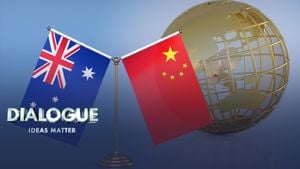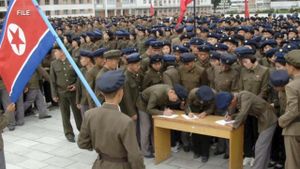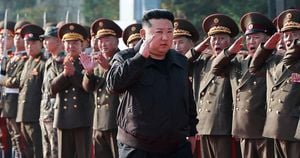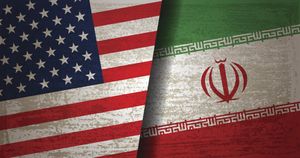China's maritime assertiveness has been inching closer to the boiling point, especially with Taiwan caught squarely in the middle. Tensions have been rising as Beijing showcases its military strength, asserting control over the Taiwan Strait and making daily incursions toward Taiwanese airspace. The concern is palpable, with international observers eager to see how the United States and allied forces stand against this intensified pressure.
Throughout October, the People's Liberation Army (PLA) has ramped up military activities around Taiwan, resulting from Government concerns over Taiwan's growing alliances with Western nations, primarily the United States. Beijing has kept its navy on heightened alert, evidenced by the recent Joint Sword 2024B exercises. This exercise showcased not just naval but also air operations focusing on potential blockades, simulating scenarios where Taiwan might be completely surrounded.
At the center of these military maneuvers, the Liaoning aircraft carrier played a prominent role, conducting sorties with its J-15 fighter-bombers making approximately 90 incursions over Taiwan's Air Defense Identification Zone (ADIZ). This continuous military posturing is interpreted as both rehearsal and intimidation, fostering fears of imminent action against Taiwan.
While China's military dominance grows, Taiwan's defense remains resilient, bolstered by the influx of military supplies from the United States and other allies. Reports indicate significant deliveries of advanced weaponry, including aerial defense systems and drones equipped for swarm attacks against seaborne threats. The latest shipments are strategically selected to counteract the anticipated threats from the PLA’s increased offensive strategies.
Interestingly, Taiwan is not alone; it has received overt signs of support from more than just the United States. Countries previously hesitant to engage with Taiwan militarily have begun offering assistance, enhancing Taipei's naval capacities and production capabilities for modern submarines and frigates. This shift signals greater regional cooperation against perceived Chinese aggression.
Japan, too, is intertwined within this military escalation narrative. Recent naval activities have seen Japanese vessels joining allied forces from Australia and New Zealand, which culminated in naval exercises traversing the Taiwan Strait. This is not just about navigation; it marks the first time Japanese naval assets have entered these waters, reflecting Japan’s commitment to regional security.
During the month of October, as tensions flared, Japan's Self-Defense Forces participated separately but alongside U.S. forces during the Keen Sword exercises. This joint drill, featuring over 45,000 personnel, was markedly noteworthy, emphasizing the readiness of U.S. and Japanese forces to react to any hostile developments occurring near Taiwan. The drills’ simulated responses included evacuations from Nansei Islands near Taiwan, juxtaposing military preparedness against China’s maritime strategies.
The increase of PLA naval and aerial operations and simultaneous responses from the U.S. and Japan creates yet another dimension to this maritime chess game. For those watching the region, one question looms larger than others: can military showdowns turn softer, or will the strain inevitably lead to conflict?
Assessments of these recent military drills and Chinese maneuvers indicate high stakes not just for Taiwan but for the entire Indo-Pacific region. The U.S. has undeniably taken proactive steps, such as deploying surveillance missions and joint operations through the Taiwan Strait, reinforcing navigational freedoms and asserting international law’s applicability over Beijing's maritime claims. Yet, beneath these actions lies the risk of miscalculations, brewing misunderstandings, and the potential for escalations.
Beijing's exercise concentrations exemplify a broader strategy where they've grown increasingly emboldened, yet their provocations are met with demonstrations of military solidarity from Japan, the U.S., and their allies. From the Japanese perspective, such military coordination is not merely incidental; rather, it serves as a reassurance of mutual commitment to peace and stability amid looming Chinese threats.
Indeed, such collaborations—joint exercises and naval passages—serve as firm reminders of the balance of power, as major state actors feel pressured to maintain peace and security against rising assertiveness. Yet, each military manifestation unravels subtly, slowly pushing boundaries and testing diplomatic ties, leaving various stakeholders recalibrated across the globe.
The political undercurrents of these tensions reflect more than just military posturing. Leaders from Taiwan, Japan, the U.S., and allied nations must navigate carefully, as military actions could conceivably interfere with diplomatic conversations aimed at de-escalation. The stakes continue to rise as the focus turns from exercises and inspections toward tangible political resolutions.
Chinese intentions remain ever-vague, fluctuated between stark militaristic confidence and delicate political diplomacy. This results-driven rhetoric begs observers to wonder whether they are truly restrained, or if this is merely part of their broader strategic game. With all eyes now on this delicate interplay, the breaking of silence may yet yield unforeseen consequences, as nations continue to navigate through treacherous waters.
The coming months are expected to remain pivotal for Taiwan and the surrounding region. The interplay of military readiness, diplomatic dialogue, and civil cooperation may herald unprecedented chapters or disastrous slips back toward hostility. With global reverberations on the line, the international community watches closely as each side moves its pieces on this increasingly complex strategic board.
Whether through deterrent collaborations, naval displays of might, or engagement of air power, the pressures ebb and flow—a diplomatic ballet graced with the shadows of conflict, yet longing for sustainable peace. The world eagerly anticipates the next moves on the chessboard, reminding us all of the thin lines drawn between cooperation, competition, and the ultimate quest for stability.



